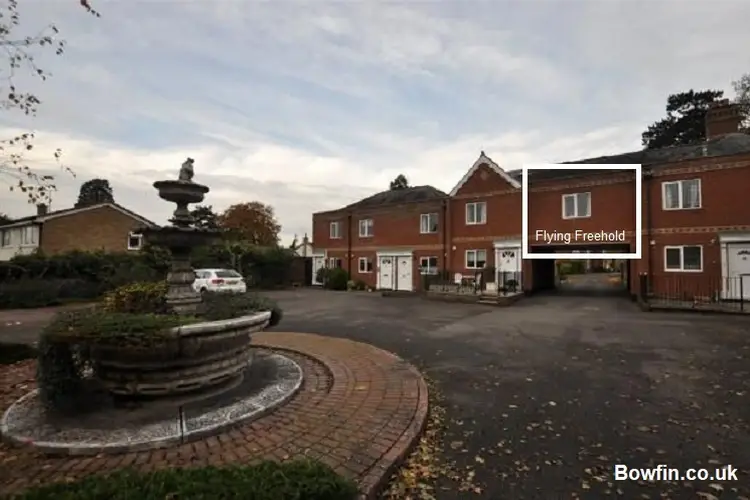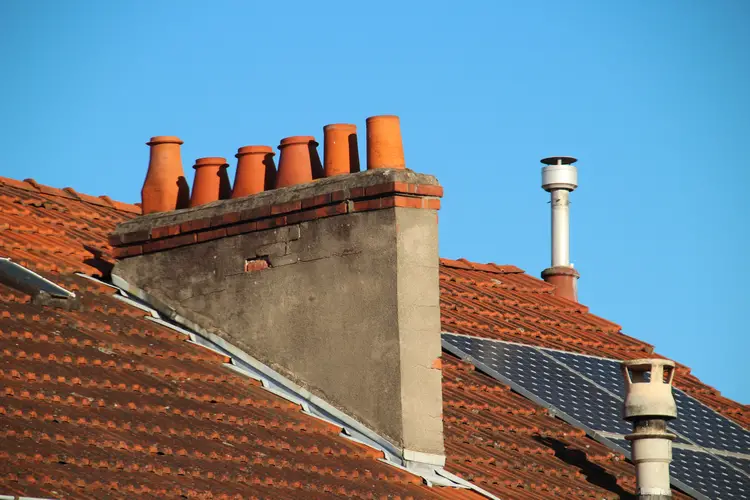
You may have found the perfect house, only to discover it has a flying freehold. Which means you may be asking whether you should buy a house with a flying freehold.
Only buy a property with a flying freehold if the flying freehold coverage is no more than 20-25% of the total gross floor area of the property, otherwise you may struggle to get a mortgage. Also the owners of the other property will need to enter into a mutual deed of covenant confirming their obligations.
What is a flying freehold?
A flying freehold is a part of a freehold property which lies over or under a part of another freehold. Flying freeholds include a part of a property that sits above a shared passageway or a part of the freehold that overhangs or underlies part of the next door neighbour’s bedroom, cellar or garage.
Examples of flying freeholds
- Properties where part of the property overhangs or underlies another freehold property.
- A property with a room that’s directly above a shared passageway.
- Properties with a balcony that overhangs the next door neighbours property.
- A property with a basement or cellar that goes underneath a neighbouring property.
- Terraced or semi-detached houses with a dividing wall that isn’t vertically straight down the middle.
- A converted attic of one freehold property overlies another freehold.

Can you get a mortgage on a property with a flying freehold?
You can get a mortgage on a flying freehold if the flying freehold coverage is less than 20% of the total gross floor area of the property. Some lenders allow up to 25% of gross floor area, whereas others limit this to 10%. A few lenders don’t lend on flying freeholds no matter how small the percentage.
Another reason why mortgage lenders won’t lend on a flying freehold is one part of the flying freehold is a commercial premises.
We require that there are appropriate mutual rights of support and maintenance and mutually enforceable covenants usually including a Deed of Covenant being entered into on each dealing with the Property between the existing/other flat owners and the incoming purchaser. It is your responsibility to advise us as to acceptability.
Legal instruction and guidance notes to solicitors and licenced conveyancers on flying freeholds – First Direct.
Most lenders normally request flying freehold indemnity insurance as part of their approval for a mortgage. This usually costs a few hundred pounds.
Mortgage lenders who don’t lend on flying freehold properties will still not lend even with the existence of flying freehold indemnity insurance.

What are flying freehold problems?
1. Refusal of access by either property owner will cause problems:
Even when the correct access rights are contained in the mutual covenants, your neighbour may still refuse access to rectify any problems. This is unlikely, but neighbour disputes do arise.
2. Neighbour disputes arise between flying freehold owners:
If you fall out with your neighbours with the flying freehold, this will make it difficult to agree about any necessary repair work or access.
3. Right of scaffolding over the property underlying the flying freehold
The owner of the upper property may require scaffolding on the outside of the building. But the owner of the lower property may refuse the right or request a fee for such right.
The right to have scaffolding erection can be missed in the mutual covenant. If so this may create a problem for the owner of the upper property.
4. Legal rights don’t always equate to what happens in practice with flying freeholds:
Just because you have the appropriate mutual covenants in place, this doesn’t always mean your neighbours will be accommodating.
The only way to resolve flying freehold disputes would be legal proceedings, which can be costly. This is what makes flying freehold indemnity insurance a top priority.
5. Noise levels between the upper and lower properties:
If the flying freehold involves a part of the property that overhangs or underlies another freehold property’s rooms, you need to check if there is adequate noise insulation between the properties.
6. Water leaks from the flying freehold to the underlying property:
If the overlying part of the flying freehold is a bathroom and there’s a leak, the water is likely to penetrate through to the underlying property.
7. New mutual deed of covenant between freehold owners:
Each time a property with a flying freehold is sold, the other owner needs to sign a new mutual deed of covenant with the new owner. But they don’t have to.
If the other freehold owner refuses to sign a new mutual covenant, this may make it impossible to get a mortgage.
8. Leaking roof of the flying freehold property may damage the underlying property:
A leaking roof on the overlying property would put the underlying property at risk too.
9. A lack of property repairs and maintenance of the upper and lower properties may cause problems:
There’s no legal obligation to maintain your property or even carry out essential repairs. If the neighbouring flying freehold property fails to carryout these repairs, this may impact the other.
10. External decoration may cause problems or disputes between freehold owners:
Disputes or disagreements can arise over external decoration to a property.
11. Insurance cover:
It’s important to make sure both property owners are under an obligation to adequately insure their property. But this doesn’t necessarily mean that each owner will insure their property.
What are the legal requirements for a flying freehold?
During the property conveyancing each property should have appropriate legal rights, which should include:
- The upper freehold property should have a right of support from the lower property.
- The lower property should enjoy a right of shelter from the upper property.
- There should be rights for each owner to enter the other person’s property to carry out any necessary repairs or maintenance.
- Each time the property is sold the neighbouring property owner must be prepared to sign a new mutual deed of covenant.
What if the flying freehold is not on Land Registry?
If the flying freehold is not on Land Registry the property will be unmortgagable. This means the only way to buy a house with an unregistered flying freehold is to notify Land Registry with the correct flying freehold details using a solicitor.

Flying freehold who owns the roof?
The roof of a flying freehold is owned by the person who owns the upper part of the property. But if the roof is damaged or falls into disrepair, both homeowners will normally be liable for the cost of the repair.
This was confirmed in a court case which went all the way to the Court of Appeal. The case was of Abbahall v Smee (2002). The Court of Appeal decided that the cost of repairing the roof had to be borne by both parties. This was on the basis that they would equally benefit.
The Appeal Court also found that the party who allowed the roof space to fall into disrepair, which had affected the property below, had a duty of care.
But your solicitor will check who is responsible for the maintenance and repair of the property during the conveyancing process.
It’s common to find properties with a flying freehold over a communal passageway that leads to a shared carpark for visitors and residents, as shown in the above image.
Problems may arise if the overlying property needs to erect scaffolding to repair or maintain the upper property. This needs to be done without restricting access through the passageway.
Or if the correct mutual deeds of covenant are not confirmed when the property was purchased could mean the owner of the underlying property may require a fee before he works can go ahead.

Flying freehold indemnity insurance cover
Flying freehold indemnity insurance provides cover against:
- Any loss in value due to the lack of maintenance or repair of the adjoining property.
- Any costs incurred by the owner of the flying freehold to prosecute legal proceedings against the adjoining freehold owner.
But before you take out insurance cover you should check the exclusions.
Also, most mortgage lenders will not accept flying freehold indemnity insurance as an alternative to obtaining mutual deeds of covenant to confirm what each owner must do or not do with their properties.
Can a flat be a flying freehold?
A flat cannot be a flying freehold as flats and apartments are leasehold properties. This means the freehold of the building is separately owned. The freeholder grants a lease to each of the flat owners.
Conclusion about should you buy a house with a flying freehold
Be aware some people may be put off if a house has a flying freehold. Not everyone has come across the concept of flying freeholds and may decide not to buy due to the unknown.
There are also many problems that can arise out of a flying freehold to consider. Most of these shouldn’t be a problem. But this often relies on you getting along with your neighbour who owns the adjacent freehold. But always bear in mind the current neighbours may sell to new homeowners who may not be as delightful.
Plus you must make sure you have the appropriate mutual deeds of covenant. These covenants confirm what each owner must do or shall not do with their property.
Flying freeholds make it more difficult to get a mortgage on the property. This is especially true if the percentage of coverage of the flying freehold is more than 20% of the gross floor area of the property.
Be aware of resale when you buy a property with a flying freehold. A flying freehold may make it more difficult to obtain a mortgage. This could in turn affect its potential value and saleability in the future. So make sure the price of the property reflects the percentage of flying freehold cover.
A flying freehold may not bother you, but it may be a problem for the next buyer.
You may also want to find out more about link detached houses, where there is a similar link between neighbouring houses.
I hope you’ve enjoyed this article about should you buy a house with a flying freehold
If you’ve enjoyed this article about “should you buy a house with a flying freehold” please share it on your favourite social media site.
Also, if you have any questions, please feel free to comment below too. Alternatively, if you need more help, please feel free to contact us on our contact us page here. Or join the discussion and ask your question in the property forum.




